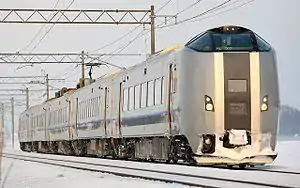KiHa 183 series
The KiHa 183 series (キハ183系) is a diesel multiple unit that has been operated on express services since 1980 under Japan National Railways and later under JR Hokkaido and JR Kyushu. Some variants were eventually built, including resort trains (the KiHa 183-5000 Niseko Express, the KiHa 183-5100 Crystal Express Tomamu & Sahoro, and the KiHa 183-5200 North Rainbow Express).
| KiHa 183 series | |
|---|---|
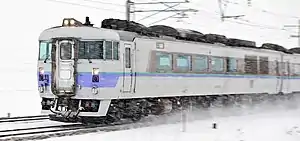 | |
| In service | 1980–present |
| Replaced | KiHa 80 series |
| Constructed | 1979–1992 |
| Number preserved | 2 |
| Successor | KiHa 261 series, KiHa 283 series |
| Operator(s) | JNR (1980–1987) JR Hokkaido (1987–present) |
| Specifications | |
| Car length | 21,300 mm (69 ft 11 in) |
| Width | 2,903 mm (9 ft 6 in) |
| Maximum speed | 130 km/h (81 mph) |
| Prime mover(s) | DMF15HSA・DML30HSI |
| Engine type | Diesel multiple unit |
| Track gauge | 1,067 mm (3 ft 6 in) |
Whilst most sets were refurbished and remain in service, some cars were also withdrawn from service - of those, three of these cars (two KiHa 183-200 cars and one KiHa 183-5000 Niseko Express car) had their restoration crowdfunded and are stored in locations around Hokkaido, 17 cars were donated to the State Railway of Thailand, and the rest were scrapped.
History
After finishing development in 1979, the 183 series went through a year and a half of testing, before entering service in 1981.
In 1986, the 500/1500 variant was introduced, replacing the 80 series trains completely; in 1988, new owner JR Hokkaido would introduce the 550/1550 variant, which was used on limited express services.[1][2]
In September 2021, it was announced that 17 cars would be donated by JR Hokkaido to the State Railway of Thailand, with them bearing the shipping costs.[3]
Manufactured cars
| 183-900 series | |
|---|---|
 183-900 series on Okhotsk service, 1990 | |
| Built at | Fuji Heavy Industries[4] |
| Entered service | 1980 |
| Scrapped | 2001 |
| Number built | 12 cars |
| Number scrapped | 12 cars |
| Capacity | 40 (KiHa 183-900 & KiRo 182-900) 68 (KiHa 182-900) 44 (KiHa 184-900) |
| Specifications | |
| Maximum speed | 100 km/h (62 mph) (early) 110 km/h (68 mph) (later) |
Prototype cars (183-900 series)
In 1979, 12 prototype cars were manufactured, which were numbered the -900 series. They were intended to be in sets made up of 7 cars, which could be extended to 10 cars for long-distance services. All cars were eventually modified to be included in production sets; all were eventually scrapped by 2001 due to age.[5]
- KiHa 183-900 (901 - 904)
- An ordinary car with a cab and a capacity of 40 passengers - four were produced in 1979. One engine was installed, along with a power generator.[5][6]
- KiHa 182-900 (901 - 906)
- An intermediate passenger car with a capacity of 68 passengers, equipped with a bathroom. Six cars were manufactured in 1979.[5]
- KiHa 184-900 (901)
- An intermediary power car equipped with one engine, an equipment room and a power generator. One car was produced in 1979, which in 1985 was integrated and remodeled into the KiRo 184-901 green car.[6]
- KiRo 182-900 (901)
- A green car equipped with a washroom and toilet. One car was manufactured in 1979, and scrapped in 2001.[6]
- KiHa 183-900 series pictures
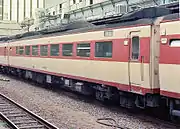 KiHa 182-901 car stopped at Sapporo Station
KiHa 182-901 car stopped at Sapporo Station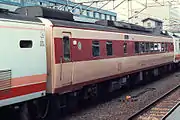 KiRo 182-901 car
KiRo 182-901 car
Initial production sets (183-0 series)
| 183-0 series | |
|---|---|
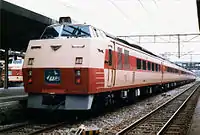 183-0 series train in Sapporo, 1986 | |
| Constructed | 1981 - 1983 |
| Entered service | 1981 |
| Scrapped | 2002 - 2018 |
| Number built | 89 cars |
| Number scrapped | 89 cars |
| Capacity | 40 (KiHa 183-0) 68 (KiHa 182-0) 44 (KiHa 184-0) 32 (KiRo 184-0) |
| Specifications | |
| Maximum speed | 100 km/h (62 mph) (early) 110 km/h (68 mph) (later) |
The initial production sets were manufactured between 1981 and 1983, resulting in 89 cars, which were divided into 4 types. With the introduction of successor vehicles such as the 283 series and 261-1000 series, all vehicles were scrapped by 2018.[7]
- KiHa 183-0 (1 - 20)
- 20 cars were manufactured. Unlike the 183-900 front cars, the windows could not be opened and the front decorative band was changed to stainless steel. Two cars were placed on the Asahiyama Zoo service, and cars 11 - 15 were refurbished into KiHa 183-200 series front cars in 1992, with an improved engine and transmission. 17 cars were donated to Thailand.[8][9]
- KiHa 182-0 (1 - 48)
- 48 cars were produced. The side ventilation openings are enlarged compared to the KiHa 182-900 cars. Three cars were remodeled for Asahiyama Zoo services.[7] Some were upgraded with a larger engine and a new transmission to become the KiHa 182-200.
- KiHa 184-0 (1 - 11)
- 11 cars were manufactured. The passenger capacity was increased to 52 by omitting the bathroom and water tank provided at the rear end. The layout of the side aisles, compared to the KiHa 182-900 cars, had been changed to eliminate the door between the deck and the equipment room.[6]
- In 1985, four cars were remodeled to KiHa 183-100 series front cars by installing a driver's cab with the same capacity as the original cars. Of those cars, two (183-101 and 183-102) were scrapped in 2008, one (183-103) was transferred to Myanmar Railways in 2009 and Thai Railway acquired the 183-104 car in 2016.[10][11]
- KiRo 182-0 (1 - 10)
- 10 cars were manufactured. Food services were expanded in this car - which included shops and kitchen-type facilities. The cabin door at the front end of the 900 series (prototype car) was relocated closer to the center of the car body, and the passenger capacity was reduced to 32 people. In 1996, 5 cars were remodeled to KiRoHa 182 cars, and by 2001, 4 cars were scrapped.[6][12]
 KiHa 183 Ozora service near Onuma Station
KiHa 183 Ozora service near Onuma Station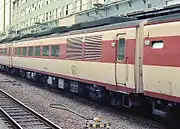 KiHa 184-8 car stopped at Sapporo Station
KiHa 184-8 car stopped at Sapporo Station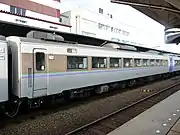 KiHa 182-42 car
KiHa 182-42 car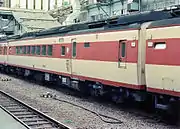 KiRo 182-5 car stopped at Sapporo Station
KiRo 182-5 car stopped at Sapporo Station
183-500 & 183-1500 series
| 183-500 & 183-1500 series (N183 series) | |
|---|---|
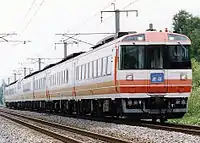 N183 Hokuto service near Osatsu Station, 1992 | |
| Constructed | 1986 |
| Entered service | 1986 |
| Scrapped | 1994-2019 |
| Number built | 36 cars |
| Number scrapped | 7 cars |
| Capacity | 60 (KiHa 183-500) 68 (KiHa 183-1500) 60 (KiHa 182-500) |
| Specifications | |
| Maximum speed | 110 km/h (68 mph) (initial) 120 km/h (75 mph) (later) |
36 cars of what would become the 183-500 and 183–1500 series were manufactured in 1986 at Niigata Engineering Co., Ltd. and Fuji Heavy Industries, with the main purpose of improving the management base of JR Hokkaido. These cars were also known as the N183 series.[13]
- KiHa 183-500 (501 - 507)
- A passenger car with a capacity of 60 people, equipped with a driver's cab and a bathroom. It uses the larger engine on the intermediate KiHa 182-500 cars and without the electricity generating engine, in order to shorten train sets and increase frequency. Six cars of this type were produced in 1986 - 502 was scrapped due to damage in 1994, 501 was scrapped in 2010, and 503 and 504 were scrapped in 2019. 505 and 506 were remodeled to 405 and 406 after upgrade works and a reduction in engine power, and 507 was remodeled to a KiHa 183-6001 car.[13]
- KiHa 183-1500 (1501 - 1507)
- A passenger car with a capacity of 68 people and a driver's cab - no bathroom was in this car. This follows the KiHa 183-0 and has two smaller engines, one for generating electricity. Seven cars of this type were manufactured in 1986.[13]
- KiHa 182-500 (501 - 514)
- An intermediate passenger car equipped with a bathroom, with a seating capacity of 68 passengers. 14 cars were produced in 1986.[13] Some were modified into the KiHa 182-400, similar to the KiHa 183-400.
- KiRo 182-500 (501 - 508)
- Eight cars of this type were built in 1986.[13]
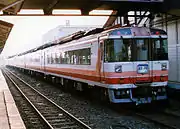 KiHa 183-500 Okhotsk service stopped at Abashiri Station
KiHa 183-500 Okhotsk service stopped at Abashiri Station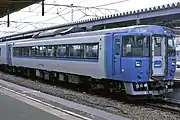 KiHa 183-1506 front car at Hakodate Station
KiHa 183-1506 front car at Hakodate Station KiHa 182-504 car near Sapporo
KiHa 182-504 car near Sapporo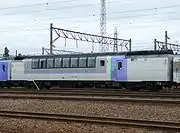 KiRo 182-508 car
KiRo 182-508 car
183-550 & 183-1550 series
| 183-550 & 183-1550 series (NN183 series) | |
|---|---|
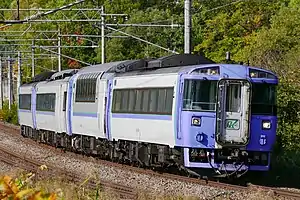 NN183 series set on Okhotsk service in 2021 | |
| Constructed | 1988 - 1991 |
| Entered service | 1988 |
| Number built | 32 cars |
| Number scrapped | 4 (KiSaRoHa 182-550) |
| Capacity | 68 (KiHa 183-1550) 68 (KiHa 182-550) 10 ordinary + 24 green (KiSaRoHa 182-550) |
| Specifications | |
| Maximum speed | 120 km/h (75 mph) - 130 km/h (81 mph) (KiSaRoHa 182-550 limited to 120 km/h (75 mph)) |
28 cars of what would become the 183-550 and 183–1550 series were manufactured by Fuji Heavy Industries between 1988 and 1990. Also known as the NN183 series, these cars would feature changes to the bathroom and interior from the N183 series cars. These cars would also see installation of a fresh air intake to ensure no engine smoke entered the cabin.[14][15][16][17][18]
- KiHa 183-1550 (1551 - 1566)
- An ordinary passenger car with a driver's cab; these cars did not feature a bathroom and had a capacity of 68 people. 16 cars of this type were manufactured between 1988 and 1990.[14][15][16][17] They also come with two smaller engines, one for electricity.
- Cars 1555 - 1566 would introduce cosmetic changes, which included changes to seat numbers and the window frame. KiHa 183-1557 was eventually remodeled into KiHa 183-6101. Some received brake upgrades to become 130km/h capable, and they became the KiHa 183-3550 and -4550 (Which can also control the brake systems of the 110/120km/h cars). Some of them have the engine swapped with a unit similar to that of a KiHa 261, and -3550/4550 were then renamed KiHa 183-8550/9550.[19][20][10]
- KiHa 182-550 (551 - 562)
- An intermediate passenger car with a boys' bathroom; 12 cars of this type were manufactured between 1988 and 1989.[14][15][16]
- Cars 555 - 562 were improved in the same way that KiHa 183-1555 to 183-1566 were, along with bathroom improvements. Some of these also received brake upgrades to become 130km/h capable, and they were renamed KiHa 183-2550. All cars were eventually refurbished into -7550 cars by engine replacement.[9][21][22]
- KiSaRoHa 182-550 (551 - 554)
- A double deck car with 10 ordinary seats on the first floor, and 24 green class seats in a 2+1 arrangement on the second floor; four cars of this type were manufactured in 1991.[18]
- This car was used on Super Tokachi services from 1991 until 2000, when they were demoted to Tokachi services due to the introduction of 283 series trains.
- In 2001, these cars were placed into storage and all four of this type were scrapped in 2013.[23]
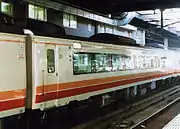 KiHa 182-550 series car at Sapporo
KiHa 182-550 series car at Sapporo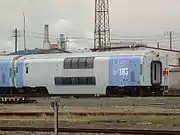 KiSaRoHa 182-550 car in storage, 2005
KiSaRoHa 182-550 car in storage, 2005
| 183-5000, 183-5100 & 183-5200 series | |
|---|---|
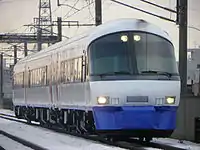 183-5000 series Niseko Express on Hakodate Main Line near Sapporo, 2010 | |
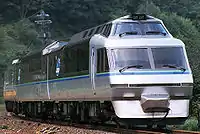 Crystal Express in 3-car configuration near Shintoku, 1990 | |
| Constructed | 1988 - 1991 |
| Entered service | 1989 (Niseko Express) |
| Number built | 12 cars (3 sets) |
| Specifications | |
| Maximum speed | 120 km/h (75 mph) |
Resort trains (183-5000, 183-5100 and 183-5200 series)
Due to the Sekishō Line opening in 1981 and the number of passengers to resort areas in the Central Hokkaido area increasing, a decision was made to modify the Alpha Continental 56 series train in 1985. After adding two services (the Furano Express and Tomamu-Sahoro Express) based on the 80 series trains, the design was changed to that of the 183 series. In total, 3 sets (12 cars) were built, and the new sets began service, starting with the Niseko Express in 1989. This was followed by the Crystal Express Tomamu & Sahoro set in the same year and the North Rainbow Express set in 1992.[24][25]
Due to age, the Crystal Express set was withdrawn from service on November 30, 2019, and was scrapped in May 2020.
183-5000 series (Niseko Express)
183-5100 series (Crystal Express Tomamu & Sahoro)
- KiHa 183-5100 (5101 - 5102)
- An ordinary driving car equipped with an observation deck. It had eight observation seats, but due to risk mitigation measures caused by a 789 series train colliding with a level crossing in January 2010, the deck was closed off.[27][28]
- KiHa 182-5100 (5101)
- An intermediate passenger car with a capacity of 56 people, equipped with a skylight.[28]
- KiSaRoHa 182-5100 (5101)
- A double-deck car built in December 1990. It is not equipped with an engine.[29]
183-5200 series (North Rainbow Express)
- KiHa 183-5200 (5201 - 5202)
- An ordinary driving car with a capacity of 47 people. KiHa 183-5201 was damaged in an accident in February 1997, and was substituted with the KiHa 183-1 car while repair works took place.[30]
- KiHa 182-5200 (5201, 5251)
- An intermediate passenger car with a capacity of 60 people.[30]
- KiSaHa 182-5200 (5201)
- A double deck passenger car with a capacity of 36 people, equipped with a buffet room on the first floor and private rooms on the second floor.[30]
- KiHa 183 series resort train pictures
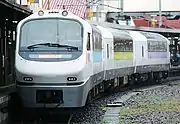 KiHa 183-5200 North Rainbow Express train on Hakodate Express service, 1992
KiHa 183-5200 North Rainbow Express train on Hakodate Express service, 1992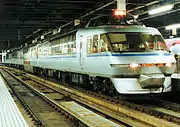 Crystal Express train, 1992
Crystal Express train, 1992
183-1000 series (JR Kyushu)
| 183-1000 series | |
|---|---|
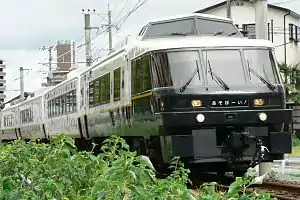 183-1000 series set on Aso Boy service, 2011 | |
| Constructed | 1988 - 1989 |
| Entered service | 1988 |
| Number built | 4 cars (1 set) |
| Capacity | 52 (KiHa 183-1000) 48 (KiHa 182-1001) |
| Specifications | |
| Maximum speed | 120 km/h (75 mph) |
| Multiple working | 485 series |
Three cars of what would be known as the 183-1000 series were manufactured in 1988 (a fourth car was built in 1989), originally exclusively for services to the Holland Village located in Nagasaki. Due to the Tosu to Mojikō section of the Kagoshima Main Line experiencing high demand, a coupler was added to the front end to enable joint working with 485 series trains.[31]
- KiHa 183-1000 (1001, 1002)
- Two cars were produced in 1988. They do not have an in-built power supply.[31]
- KiHa 182-1000 (1001, 1002)
- An intermediate car; one (1001) was manufactured in 1988, and was equipped with a power supply as well as cafe and small rooms. Another car (1002) was manufactured in 1989 and came equipped with an engine as well as having an onboard children's play area.[31]
- KiHa 183-1000 series pictures
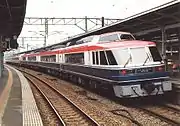 KiHa 183-1000 Holland Village Express service coupled with 485 series train at Kokura, 1990
KiHa 183-1000 Holland Village Express service coupled with 485 series train at Kokura, 1990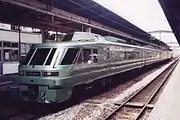 KiHa 183-1000 Yufuin no Mori II train stopped at Hakata, 1992
KiHa 183-1000 Yufuin no Mori II train stopped at Hakata, 1992
Special services
Asahiyama Zoo
In 2007, several KiHa 183–0 series cars were renovated for use on the Asahiyama Zoo limited express service (which was named because of the zoo's popularity) from Sapporo to Asahikawa, which also made stops at Iwamizawa and Takikawa stations.[11]
Designed by former zookeeper and children's book author Hiroshi Abe, the complete set consisted of the Polar Bear (KiHa 183–3), Wolf (KiHa 182–46), Lion (KiHa 182–47), Chimpanzee (KiHa 182–48), and Penguin (KiHa 183–4) cars, and the external livery consisted of drawn children and animals.[11]
In addition to changes to the children's playroom in the Polar Bear car and the introduction of a nursing room in the Penguin car, each car was equipped with a seat that was shaped like an animal (known as a "hug-hug" chair), intended for photography. These were replaced with stuffed animals in some seats in 2013.[11][32]
This set ran from 2007 (with a brief pause between April and July 2013 due to refurbishment works) to March 2018, when the set was scrapped.[33][34][7] The Asahiyama Zoo service was transferred to 789 series trains, and was eventually integrated with Lilac services.
 Pre-refurbishment Asahiyama Zoo service between Naebo and Shiraishi
Pre-refurbishment Asahiyama Zoo service between Naebo and Shiraishi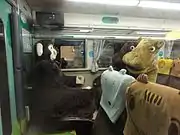 "Hug-hug" chair in pre-refurbishment Chimpanzee car
"Hug-hug" chair in pre-refurbishment Chimpanzee car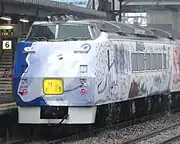 Post-refurbishment Asahiyama Zoo set
Post-refurbishment Asahiyama Zoo set "Hug-hug" chair located in Tropical Jungle post-refurbishment car
"Hug-hug" chair located in Tropical Jungle post-refurbishment car
Preserved cars
183-214, 183-220
The restoration of 183-214 was funded by crowdfunding, and after being restored to JNR colors, it eventually was placed in the Abira Roadside Station, alongside 183–220.[35][36]
Whilst 183-214 is on public display, 183-220 is in storage.[35]
183-5001 (Niseko Express)
After having its restoration crowdfunded, it is now stored at the Arishima Memorial Hall.[37]
See also
References
- "Railway Journal". Railway Journal (in Japanese). 21 (1): 16–27. January 1987.
- 『JR編集時刻表』 [JR Editorial Timetable] (in Japanese). Kosai Publishing Co. March 1988.
- "「キハ183系 タイで復活へ/中古ディーゼル車譲渡 来年にも運行」" [KiHa 183 series to be revived in Thailand / Used diesel vehicles to be transferred to Thailand for operation next year]. Hokkaido Shimbun (in Japanese). September 12, 2021.
- 形式キハ183・185系 あの車両のすべてを徹底解明 国鉄とJRとを繋いだ非電化区間のエース [The KiHa 183 and 185 series - the ace of the non-electrified section that connected JNR and JR]. イカロスMOOK 国鉄型車両の系譜シリーズ 08 [Ikaros MOOK Genealogy of Japanese National Railways Rolling Stock Series 08] (in Japanese). Vol. 8. Ikaros Publishing. April 2008. pp. 102–109. ISBN 978-4-86320-033-3.
- "JR各社の車両配置表2002/JRグループ車両データバンク2001-2002(特集:JR車両ファイル2002)" [Rolling Stock Allocation Table of JR Companies 2002 / JR Group Rolling Stock Data Bank 2001-2002 (Special Feature: JR Rolling Stock File 2002)]. Japan Railfan Magazine (in Japanese). 交友社. 42 (496). August 1, 2002.
- "JR各社の車両配置表2001/JRグループ車両データバンク2000-2001(特集:JR車両ファイル2001)" [Rolling Stock Allocation Table of JR Companies 2001 / JR Group Rolling Stock Data Bank 2000-2001 (Special Feature: JR Rolling Stock File 2001)]. Japan Railfan Magazine (in Japanese). 交友社. 41 (484). August 1, 2001.
- Tezuka, Kazuyuki (July 1, 2019). "車両のうごき2018-2019(特集:JR車両ファイル2019)" [Rolling Stock Movements 2018-2019 (Feature: JR Rolling Stock File 2019)]. Japan Railfan Magazine (in Japanese). Koyusha. 59 (699).
- "รู้จัก KiHa 183 ของ JR Hokkaido รถไฟมือสองที่ไทยซื้อจากญี่ปุ่น". news.trueid.net (in Thai). Retrieved January 17, 2022.
- Editorial (September 1, 1994). "JR各社の車両配置表1994(特集:JR予報 車両最前線)" [Rolling Stock Layout of JR Companies 1994 (Special Feature: JR Forecast Rolling Stock Front Line)]. Japan Railfan Magazine (in Japanese). 交友社. 34 (401).
- Tezuka, Kazuyuki (July 1, 2017). "車両のうごき2016-2017(特集:JR車両ファイル2017)" [Rolling Stock Movements 2016-2017 (Feature: JR Rolling Stock File 2017)]. Japan Railfan Magazine (in Japanese). Koyusha. 57 (675): 58–67.
- Tezuka, Kazuyuki (July 1, 2008). "車両のうごき2007-2008(特集:JR車両ファイル2008)" [Rolling Stock Movements 2007-2008 (Special Feature: JR Rolling Stock File 2008)]. Japan Railfan Magazine (in Japanese). Koyusha. 48 (567): 66–83.
- "全JR7社の車両配置表1997(特集:JR車両ファイル1997)" [Rolling Stock Layout List of All Seven JR Companies 1997 (Special Feature: JR Rolling Stock File 1997)]. Japan Railfan Magazine (in Japanese). Koyusha. 37 (435). July 1, 1997.
- "特別付録『国鉄最後の車両配置表』(特集:JR旅立ち特大号)" [Special Appendix: "The Last Rolling Stock Layout Chart of the Japanese National Railways" (Special Feature: JR Tabidachi Special Edition)]. Japan Railfan Magazine (in Japanese). Koyusha. 27 (314). June 1, 1987.
- "JR各社の車両配置表1988(特集:JR車両のうごき)" [JR rolling stock layout chart 1988 (Special Feature: Rolling Stock of JR)]. Japan Railfan Magazine (in Japanese). 328. August 1988.
- "JR各社の車両配置表1989(特集:88/89 JR車両のうごき)" [Rolling Stock Layout of JR Companies 1989 (Special Feature: 88/89 Rolling Stock of JR)]. Japan Railfan Magazine (in Japanese). 339. July 1989.
- "JR各社の車両配置表1990(特集:JR車両 file 90)" [Rolling Stock Layout of JR Companies 1990 (Special Feature: JR Rolling Stock file 90)]. Japan Railfan Magazine (in Japanese). 351. July 1990.
- "JR各社の車両配置表1991(特集:JR車両 file 91)" [Rolling Stock Layout of JR Companies 1991 (Special Feature: JR Rolling Stock file 91)]. Japan Railfan Magazine (in Japanese). 364. August 1991.
- "JR各社の車両配置表1992(特集:JR車両 file 92)" [Rolling Stock Layout of JR Companies 1992 (Special Feature: JR Rolling Stock file 92)]. Japan Railfan Magazine (in Japanese). 376. August 1992.
- Tezuka, Kazuyuki (July 1, 2015). "車両のうごき2014-2015(特集:JR車両ファイル2015)" [Rolling Stock 2014-2015 (Special Feature: JR Rolling Stock File 2015)]. Japan Railfan Magazine (in Japanese). Koyusha. 55 (651): 70–81.
- Tezuka, Kazuyuki (July 1, 2016). "車両のうごき2015-2016(特集:JR車両ファイル2016)" [Rolling Stock Movements 2015-2016 (Special Feature: JR Rolling Stock File 2016)]. Japan Railfan Magazine (in Japanese). Koyusha. 56 (663): 62–75.
- "車両のうごき2014-2015(特集:JR車両ファイル2015)" [Rolling Stock 2014-2015(Feature: JR Rolling Stock File 2015)]. Japan Railfan Magazine (in Japanese). 651. June 2015.
- "車両のうごき2015-2016(特集:JR車両ファイル2016)" [Rolling Stock Movements 2015-2016 (Special Feature: JR Rolling Stock File 2016)]. Japan Railfan Magazine (in Japanese). 663. July 2016.
- Tezuka, Kazuyuki (July 1, 2014). "車両のうごき2013-2014(特集:JR車両ファイル2014)" [Rolling Stock Movements 2013-2014 (Special Feature: JR Rolling Stock File 2014)]. Japan Railfan Magazine (in Japanese). Koyusha. 54 (639): 62–73.
- "さらば!「アルファコンチネンタルエクスプレス」" [Farewell! "Alfa Continental Express"]. Japan Railfan Magazine (in Japanese). 408: 71–80. April 1995.
- "トマム・サホロエクスプレス JR北海道3番目のリゾート特急 札幌駅で出発式" [Tomamu Sahoro Express, JR Hokkaido's third resort express, departure ceremony at Sapporo Station]. Kōtsū Shimbun (in Japanese). December 23, 1992.
- "JR北海道 アメニティリゾート・ニセコエクスプレス" [JR Hokkaido Amenity Resort - Niseko Express]. Japan Railfan Magazine (in Japanese). 334: 16–20. February 1988.
- Railway Journal (in Japanese). Vol. 526. Railway Journal Company. August 2010. p. 147.
- "新車ガイド・JR北海道リゾートトレイン Part5" [New Car Guide - JR Hokkaido Resort Train Part 5]. Japan Railfan Magazine (in Japanese). 346: 10–14. February 1990.
- "キサロハ182形 (5101) クリスタルエクスプレス増備車" [KiSaRoHa 182 (5101) Crystal Express Expansion Car]. Tetsudo Pictorial (in Japanese). 550: 26. October 1991.
- Sato, Iwao (September 1992). "JR北海道 キハ183系5200番台" [JR Hokkaido Kiha 183 Series 5200]. Japan Railfan Magazine (in Japanese). Koyusha. 32 (9): 60–64.
- Japan Railfan Magazine (in Japanese). Vol. 457. May 1995. p. 136.
- "〜7月13日の運転よりデザインが新しくなります〜 特急「旭山動物園号」リニューアルデビュー!!" [The Asahiyama Zoo Limited Express will make its debut on July 13, 2012!] (PDF). www.jrhokkaido.co.jp (pdf) (in Japanese). JR Hokkaido. Archived from the original (PDF) on October 14, 2013. Retrieved September 6, 2014.
- "〜7月13日の運転よりデザインが新しくなります〜 特急「旭山動物園号」リニューアルデビュー!!" [The Asahiyama Zoo Limited Express will make its debut on July 13, 2013!] (PDF) (in Japanese). JR Hokkaido. May 15, 2013. Archived from the original (PDF) on October 14, 2013. Retrieved September 6, 2014.
- "特急「ライラック旭山動物園号」に乗って旭山動物園へ行こう!" [Let's go to Asahiyama Zoo on the express train "Lilac Asahiyama Zoo"!] (PDF) (in Japanese). JR Hokkaido. May 19, 2017. Archived (PDF) from the original on May 20, 2017. Retrieved May 28, 2017.
- "気動車:鉄道愛好家にっこり 「キハ183系」保存2両に - 毎日新聞" [Diesel train: Railroad enthusiasts smile as two KiHa 183 series cars are preserved]. Mainichi Shimbun (in Japanese). Archived from the original on July 9, 2021. Retrieved September 23, 2020.
- "北海道・鉄道史の誇り。往年の「特急おおぞら」を国鉄色で未来へ - クラウドファンディング" [The pride of Hokkaido's railroad history. Bringing the "Limited Express Ozora" of yesteryear to the future in JNR colors - Crowdfunding]. readyfor.jp (in Japanese). Archived from the original on July 7, 2019. Retrieved July 7, 2019.
- "ニセコエクスプレスの、里帰り。キハ183-5001号を守り抜く! - クラウドファンディング" [The Niseko Express, back home. Protecting Kiha 183-5001! - Crowdfunding]. readyfor.jp (in Japanese). Archived from the original on July 5, 2019. Retrieved July 7, 2019.
| Wikimedia Commons has media related to JNR Kiha 183 series. |
